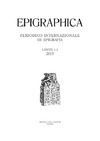Identificador persistente para citar o vincular este elemento:
https://accedacris.ulpgc.es/jspui/handle/10553/13793
| Campo DC | Valor | idioma |
|---|---|---|
| dc.contributor.author | Ramírez-Sánchez, Manuel | en_US |
| dc.contributor.author | García Sánchez, Manel | en_US |
| dc.contributor.author | Giralt Soler, Sebastià | en_US |
| dc.date.accessioned | 2015-07-06T14:32:58Z | - |
| dc.date.accessioned | 2018-03-15T14:35:37Z | - |
| dc.date.available | 2015-07-06T14:32:58Z | - |
| dc.date.available | 2018-03-15T14:35:37Z | - |
| dc.date.issued | 2015 | en_US |
| dc.identifier.issn | 0013-9572 | en_US |
| dc.identifier.uri | https://accedacris.ulpgc.es/handle/10553/13793 | - |
| dc.description.abstract | Los avances experimentados en los últimos años en las tecnologías basadas en el procesamiento de las fotografías digitales, permite abordar proyectos de modelización 3D de inscripciones romanas, como el realizado en el Museo Arqueológico Nacional (Madrid). La utilización de esta tecnología innovadora aporta a los especialistas mejores reproducciones que la fotografía convencional, que supondrán un enriquecimiento de las bases de datos epigráficas, pero su utilidad se extiende también a la propia enseñanza de la Epigrafía. | en_US |
| dc.description.abstract | The most recent advances in digital image processing have made 3D scanning of Roman inscriptions a reality, the project carried out in the Madrid Archeological Museum being just one clear example of this. The use of this innovative technology has furnished scholars with better epigraphic data; its applications, however, go far beyond these boundaries, extending to new ways of teaching Epigraphy itself. | en_US |
| dc.language | spa | en_US |
| dc.relation.ispartof | Epigraphica | en_US |
| dc.source | Epigraphica [ISSN 0013-9572], n. 77, p. 371-396 | en_US |
| dc.subject | 5505 Ciencias auxiliares de la historia | en_US |
| dc.subject | 550503 Epigrafía | en_US |
| dc.subject.other | Epigrafía | en_US |
| dc.subject.other | 3D | en_US |
| dc.subject.other | Patrimonio digital | en_US |
| dc.subject.other | Fotografía digital | en_US |
| dc.subject.other | Epigraphy | en_US |
| dc.subject.other | Digital Heritage | en_US |
| dc.subject.other | Digital photography | en_US |
| dc.title | Epigraphia 3D. Un proyecto de innovación científica en la divulgación del patrimonio epigráfico de Hispania | en_US |
| dc.title.alternative | 3D Epigraphy. A project of scientific innovation in the dissemination of Spanish epigraphic heritage | en_US |
| dc.type | info:eu-repo/semantics/article | en_US |
| dc.type | Article | en_US |
| dc.identifier.scopus | 84962022196 | - |
| dc.contributor.authorscopusid | 56354590600 | - |
| dc.contributor.authorscopusid | 57198646994 | - |
| dc.contributor.authorscopusid | 57188643922 | - |
| dc.identifier.absysnet | 713951 | - |
| dc.identifier.crisid | 2500;-;- | - |
| dc.description.lastpage | 396 | - |
| dc.description.firstpage | 371 | - |
| dc.relation.volume | 77 | - |
| dc.investigacion | Artes y Humanidades | en_US |
| dc.rights.accessrights | info:eu-repo/semantics/openAccess | - |
| dc.type2 | Artículo | en_US |
| dc.identifier.external | 2500;-;- | - |
| dc.identifier.external | 2500;-;- | - |
| dc.utils.revision | Sí | en_US |
| dc.identifier.ulpgc | Sí | es |
| dc.description.sjr | 0,152 | |
| dc.description.sjrq | Q3 | |
| item.grantfulltext | open | - |
| item.fulltext | Con texto completo | - |
| crisitem.author.dept | GIR IATEXT: Patrimonio cultural: textos, materialidades y memorias | - |
| crisitem.author.dept | IU de Análisis y Aplicaciones Textuales | - |
| crisitem.author.dept | Departamento de Ciencias Históricas | - |
| crisitem.author.orcid | 0000-0002-4935-7313 | - |
| crisitem.author.parentorg | IU de Análisis y Aplicaciones Textuales | - |
| crisitem.author.fullName | Ramírez Sánchez, Manuel Enrique | - |
| Colección: | Artículos | |
Citas SCOPUSTM
5
actualizado el 08-jun-2025
Visitas
447
actualizado el 27-sep-2025
Descargas
294
actualizado el 27-sep-2025
Google ScholarTM
Verifica
Comparte
Exporta metadatos
Este elemento está sujeto a una licencia Licencia Creative Commons

